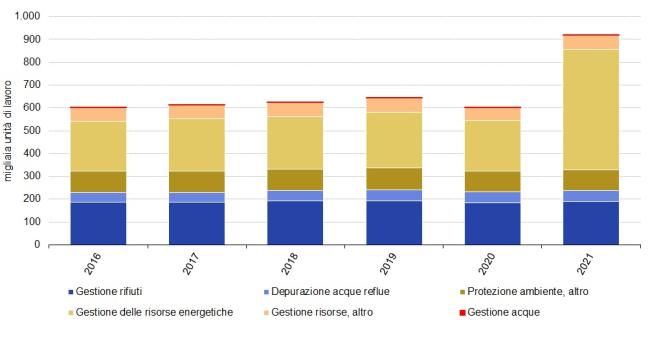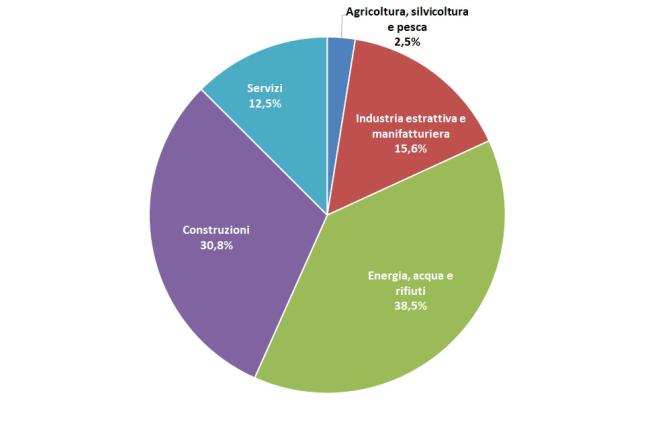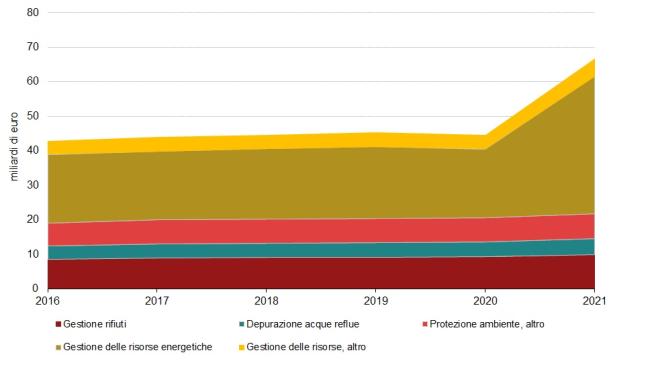Panel 1
Renato Marra Campanale
The indicators derived from the Environmental Goods and Services Accounts provide information on the main economic indicators (employment, added value, and production) of ecoindustries, i.e., producers of goods and services for environmental protection (activities to prevent, reduce, and eliminate pollution and other forms of environmental degradation) and for natural resource management (conservation, maintenance, and protection of natural resources from depletion phenomena). Employment and added value in the ecoindustry sector grew by 52.8% and 47.5%, respectively, from 2016 to 2021. This increase was almost entirely achieved in the last year (2021). In 2021, the growth of the added value in the environmental sector was significantly higher than that of GDP. This allowed for an increase in the incidence of the environmental sector's added value on GDP from 2.7% in 2020 to 3.7% in 2021.
The indicators derived from the Environmental Goods and Services Accounts (EGSS) provide information - employment, added value, production, and exports - on producers of goods and services (ecoindustries) for environmental protection (activities to prevent, reduce, and eliminate pollution and other forms of environmental degradation) and for natural resource management (conservation, maintenance, and protection of natural resources from depletion phenomena).
Ecoindustry production is carried out by the market operators sector (the predominant sector), non-market operators (public administration and social institutions serving households), and by all economic operators for re-use in the production process (e.g., material recovery activities for reinsertion into the production process) or for final consumption (e.g., solar energy produced and consumed within households). EGSS is part of the environmental satellite accounts developed by the European Statistical System in line with the principles, definitions, and classifications underlying national economic accounts, and in accordance with the principles outlined in the international statistical standard "System of Environmental-Economic Accounting - Central Framework" (2012). Environmental goods and services include many products, such as renewable energy, electric vehicles, organic agricultural production, wastewater treatment, waste management services, and the rehabilitation of mining sites. The distinction between environmental and non-environmental products is not always easy. In principle, environmental goods and services have an environmental purpose, identified by jointly considering the actual environmental impact and the technical characteristics of the product, which must be suitable for protecting the environment or conserving natural resources. This environmental purpose is statistically included in two international classifications: the Classification of Environmental Protection Activities (CEPA) and the Classification of Resource Management Activities (CReMA). CEPA activities focus on environmental protection to prevent, reduce, and eliminate pollution and environmental degradation, while CReMA focuses on natural resource management for their protection and conservation. The specific categories include: CEPA 1: Air and climate protection; CEPA 2: Wastewater management; CEPA 3: Waste management; CEPA 4: Protection and remediation of soil, groundwater, and surface waters; CEPA 5: Noise and vibration control (excluding workplace environment protection); CEPA 6: Biodiversity and landscape protection; CEPA 7: Radiation protection (excluding workplace and nuclear accident risks); CEPA 8: Research and development; CEPA 9: Other environmental protection activities; CReMA 10: Water management; CReMA 11: Forest resource management, including: 11A: Management of forest areas; 11B: Reduction of forest resource consumption; CReMA 12: Wildlife and plant management; CReMA 13: Energy resource management, including: 13A: Production of energy from renewable sources; 13B: Energy management and saving; 13C: Reduction of fossil energy use as raw materials; CReMA 14: Mineral resource management; CReMA 15: Research and development activities in resource management; CReMA 16: Other resource management activities.
The purpose is to provide economic and employment data for economic activities that produce environmental goods and services and to assess their impact on corresponding indicators for the overall economy.
Regulation (EU) No. 691/2011 on European Environmental Economic Accounts, as amended by Regulation (EU) No. 538/2014. At the end of 2019, the European Commission presented the "European Green Deal" Communication to reorient European commitments towards achieving a sustainable, resource-efficient, and competitive economy. The goods and services produced by ecoindustries are crucial for achieving these objectives.
Panel 2
Environmental goods and services sector accounts — Handbook 2016 edition. Eurostat, Luxembourg (https://ec.europa.eu/eurostat/web/products-manuals-and-guidelines/-/KS-GQ-16-008)
System of Environmental-Economic Accounting 2012 - Central Framework. United Nations, New York, 2014 (https://seea.un.org/content/seea-central-framework)
Data quality assessment
EUROSTAT (European Statistical Office), ISTAT (Italian National Institute of Statistics)
Istat: http://dati.istat.it/Index.aspx --> Conti nazionali --> Conti ambientali --> Conti dei beni e servizi ambientali
National
2016-2021
Indicator assessment
The methodology for calculating the indicator is available in the document "Environmental goods and services sector accounts — Handbook 2016 edition." Eurostat, Luxembourg (https://ec.europa.eu/eurostat/web/products-manuals-and-guidelines/-/KS-GQ-16-008)
In 2021, ecoindustries, with about 921,000 jobs, generated almost 60 billion euros in added value. The added value of ecoindustries represented 3.7% of Italy's GDP in 2021, compared to the European average of 2.5% in the same year (Table 1).
Between 2016 and 2021, employment and added value in ecoindustries showed growth (52.8% and 47.5%, respectively), with a significant increase in 2021 after a moderate rise until 2019 and a drop concurrent with the pandemic crisis. The environmental sector recorded greater dynamism than the overall Italian economy (Figure 1).
Data
Table 1: Ecoindustry indicators by economic activity. Italy, 2021.
Istat e Eurostat




The positive trend affected all areas of the sector, particularly activities aimed at improving energy efficiency (within energy resource management, Figure 2 for employment and Figure 4 for added value), primarily driven by European regulations (Directive 2010/31/EU), which from 2021, required all new or deeply renovated buildings to comply with the European nZEB (nearly Zero Energy Building) standard with very high performance levels. Moreover, energy resource management includes the positive effects from the production of energy from renewable sources, boosted by the increase in the base price driven by the positive trend in gas prices in 2021. In general, energy resource management activities accounted for 57% of employment and nearly 60% of added value in 2021.
The ecoindustry sector can also be analyzed by economic activity, providing a complementary view to the environmental domain analysis (Table 1 and Figure 3). In 2021, most of the employment came from the construction sector (43%), but it is the energy, water, and waste management sector that generated the highest share of added value (38.5%). This sector also shows the highest labor productivity, expressed by the ratio of added value to employment.